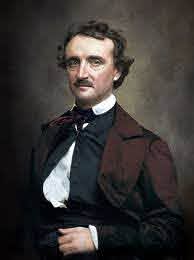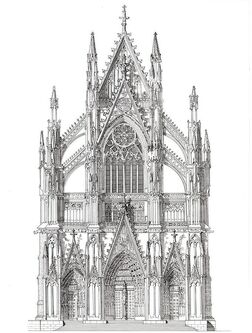Introduction to Edgar Alan Poe’s Works and American Dark-Romanticism
American Literature
|
Edgar Allan Poe was born in 1809 in Boston and died in 1849 in Baltimore. He is credited with developing the Gothic horror story, and being a significant early forerunner of the science-fiction form. Edgar Allan Poe, as well as Herman Melville and Nathaniel Hawthorne, contributed to creating the subgenre of Dark-Romanticism.
In order to understand and appreciate Poe’s work, it is necessary to understand the literary movement within which it was written (Romanticism), as well as the influence Gothic literature exerted on his fictions. |
A | Romanticism
It was a movement that arose gradually, evolved in many ways, went through so many phases, and was practiced by numerous writers. Romanticism started as a reaction against the rationalism of the Age of Reason. It was characterized by its emphasis on emotions and individualism, as well as glorification of all the past and nature, preferring the medieval rather than the classical. In America, it dominated the literary scene from around 1820 to the end of the Civil War (1865) and the rise of Realism.
The Romantic Movement is also characterized by a celebration of the sublime, and a belief in individualism.
The Romantic Movement is also characterized by a celebration of the sublime, and a belief in individualism.
Oxford definition of romanticism
Oxford Definition of Romanticism
A style and movement in art, music and literature in the late 18th and early 19th century, in which strong feelings, imagination and a return to nature were more important than reason, order and intellectual ideas.
A style and movement in art, music and literature in the late 18th and early 19th century, in which strong feelings, imagination and a return to nature were more important than reason, order and intellectual ideas.
The sublime
The Sublime :
The sublime is an emotional experience a person goes through when confronted with a situation which seeks to inspire respect and fear (awe-inspiring). It becomes a way to also find beauty in something which may be regarded as otherwise frightening.
The sublime is an emotional experience a person goes through when confronted with a situation which seeks to inspire respect and fear (awe-inspiring). It becomes a way to also find beauty in something which may be regarded as otherwise frightening.
B | Gothic literature
|
Origins :
The word Gothic originally describes a style of European architecture (primarily employed in churches) which flourished from the 12th through the 16th centuries. Gothic architecture used pointed arches and vaults and narrow spires, stained glass windows, intricate patterns; and varied details. Its upward movement was meant to suggest heavenward aspiration. Feelings and emotions :
The Gothic style expressed the essence of the Catholic faith, concerned with creating a sense of the numinous (sacré), of the presence of God. The style, with its pointed arches and spires, was meant to inspire a feeling verticality and elevation, as if the building was reaching up towards heaven. |
Why is it called “Gothic” architecture?
The term was first used during the later Renaissance as a pejorative term. Italians of the time were interested in characterizing this style as non-classical, which they identified with the Goths (i.e. Germans - but also the peoples who conquered the Romans, destroying Classical civilization.) However, it is worth underlying the fact that the style originated in France, and during the Middle Ages, well after the Goths.
Why is it called "gothic" literature?
Why is it called Gothic Literature?
The term Gothic came to be applied to the literary genre precisely because the genre commonly used such natural settings as castles, mansions, monasteries, medieval ruins or other buildings in this style.
The term Gothic came to be applied to the literary genre precisely because the genre commonly used such natural settings as castles, mansions, monasteries, medieval ruins or other buildings in this style.
Gothic Novels are English novels dealing with frightening or magic subjects. Most Gothic novels are set in ruined castles or large old houses with ghosts, and were written in the late 18th and early 19th centuries. The style was made popular by Horace Walpole's The Castle of Otranto (1764), and influenced writers such as Mary Shelley and Edgar Allan Poe, as well as 20th-century horror stories and horror films.
For Romantic poets and painters of the 19th century, Gothic architecture created strong sensations of terror, that provoked a feeling of “awe” (mix of fear and fascination). The European Romantic movement reached America in the early 19th century, and American Romantic Gothic literature made an early appearance with Washington Irving's The Legend of Sleepy Hollow (1820) .
For Romantic poets and painters of the 19th century, Gothic architecture created strong sensations of terror, that provoked a feeling of “awe” (mix of fear and fascination). The European Romantic movement reached America in the early 19th century, and American Romantic Gothic literature made an early appearance with Washington Irving's The Legend of Sleepy Hollow (1820) .
C | Dark- Romanticism
Dark Romanticism is a literary subgenre of Romanticism. Dark Romanticism evolved from the combination of Romantic and Gothic elements in stories. In other words, Dark Romanticism is a gloomier form of Romanticism because it includes several Gothic elements. While Romanticism glorifies the inherent sublimity of human intentions, Dark Romanticism is characterized by a preoccupation with emotions like apprehension, fear, and the grotesque aspect of imagination.
As a consequence, the motives found in Dark Romanticism belong to the realm of “the uncanny” (le mystérieux) :
- Love becomes lust,
- Nature features mist and lightning
- Buildings often feature haunts and ruination.
The most famous Dark-Romantic authors in American Literature are Edgar Alan Poe, Nathaniel Hawthorne and Herman Melville. They each left a significant impact on American literature. By mixing Romanticism and the Gothic, each popular literary movement in their day, they created the new subgenre of Dark Romanticism.
Conclusion
Edgar Allan Poe (1809-49) is perhaps the best-known American Dark-Romantic author - a Romantic who worked in the so-called Gothic mode. His poems and stories explore the darker side of the Romantic imagination, dealing with the mysterious, the supernatural, and the horrifying. Poe writes using a different type of Romanticism, one that combines the well-known aspects of traditional Romanticism with the darker themes of Gothic fiction.


